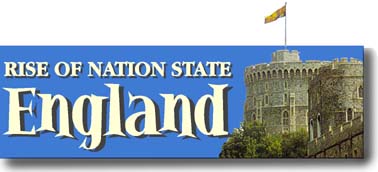|
|


Mr. Sedivy's
History Classes:









More Features:


 

 

|
|
Highlands Ranch High School - Mr. Sedivy
Highlands Ranch, Colorado
Rise of Nation State England
- The Return of the Vikings
-
The Return of the Vikings
This is how the Anglo-Saxon Chronicle described the early raids:
980 - Southampton
was ransacked by a naval force, and most of the citizens killed or
taken captive; and in that same year Thane was ravaged.
981 - Great
damage was done everywhere by the coast both in Devon and Cornwall.
982 - Three
ships of Vikings arrived in dorset and ravaged in Portland. That same
year London was burnt down. The English were no match for them. Things
might have been different, if there had been another Alfred to defend
England.

Silver penny of Eric Bloodaxe (947 - 954), Viking king
of York
Vikings in the Time of Alfred the Great
In their language, a "viking" was a pirate. To go "a-viking" meant
an adventure overseas. (Some of their victims called them "Northmen.")
Undefended monastery churches, with gold candlesticks, cups and other
valuable ornaments, were obvious targets for these heathen pirates.
For more than 200 years, no part of the coasts of Western Europe was
safe from the merciless Vikings.
Viking Ships
Viking ships were a great improvement on the rowing galleys that carried
the English settlers to Britain. Each had a proper "keel" or "backbone"
made of a single length of oak. This was strong enough to stand the
strain of a mast and a large square sail. The "steer-board" or rudder,
was shaped like the blade of an oar and fixed on the right-hand side
of the hull, near the stern. This side of a ship is still called the
starboard (from steer-board). It had a sail, but its main power came
from sixteen oars on each side. The crossing only took 28 days. They
set their course by the position on the sun, to the pole-star after
dark. If they met storms or fog they drifted aimlessly, but when the
sky cleared they could correct their course.
Voyages of the Norsemen
There were three main Viking races, the Norwegians of Norway, the
Danes of the Netherlands, and the Swedes of Sweden.
Early Raids on Britain - Norsemen
The earliest raids on Britain were carried out by Norwegians, the
"Norsemen." Plunder wasn't their only aim. They were also searching
for new places to live. They were looking for good farming land. Norsemen
began to settle on Shetlands. The Shetlands were ideal bases for attacks
on Ireland.
Lonely Iceland was the next place to be settled by Norsemen. Too
cold for growing grain crops, it had grassy regions suitable for cattle
and sheep.
Eric the Red
In 982, a tough Norseman called "Eric the Red" (he had red hair) killed
a man and was banished from Iceland for three years. So, he set off
exploring the land to the west. After much searching, he found a few
areas of grassland along the coast. Eric returned to Iceland. He thought
that people would want to go there if it had an attractive name! Sure
enough, when Eric went back to "Greenland" he was followed. In 1000,
Leif Ericson, son of Eric the Red, went to explore this new country.
He ended up in Newfoundland.
Danish Attacks
Then the Vikings headed for France, Germany, and eastern England.
They grew bolder and sailed up great rivers. They bring destruction
deep into the heart, 200 miles up the river Seine to ransack Paris.
Alfred vs Danish Guthrum
King Ethelred and his brother, Alfred, led men of Wessex. Ethelred
died suddenly in April 871, leaving the kingdom and all English hopes
in hands of his brother, Alfred. Alfred bribed the Danes with money
to leave his kingdom. They rode off toward London, and five years
went by before they returned to Wessex. To make a long story short,
the Danes returned after three battles. Alfred wins, peace was made,
and the Danes promised to leave Wessex for good.
Guthrum was baptized a Christian, with Alfred as his godfather. Then
the Viking chief led his men across the country to East Anglia, where
they settled peacefully to "plough" the land and sow crops. Alfred
was now the real ruler of all the English living outside of Danish
settlements. In 886, he made another pact with Guthrum, which fixed
a frontier between the English lands.
King Alfred's and Guthrum's pact also forbade cattle-stealing across
the frontier. "If a man be killed, whether an Englishman or a Dane,
we shall all place the same value on his life." Although the threat
of the Great Army was over, Alfred decided to strengthen his defenses
in case of future attack. He built "burhs." This is where the word
"borough" comes from. He was soon put to the test In 892, when a large
force of Danes crossed the Channel from France and landed on the Kent
coast. Most of Alfred's burhs held firm. The invaders were finally
defeated.
England now enjoyed a long period of peace. But, Viking raids against
the weak Frankish Kingdom went on unchecked. The French king, Charles
"the Simple" invited a Viking chieftain named Rollo to become the
lawful ruler of the lands. He controlled at the mouth of the River
Seine. In return, Rollo had to promise to protect Charles against
further raids. They mixed with the Franks, converted them to Christianity,
and taught them to speak French. The "Duchy of the Northmen" became
known as Normandy.
Back to top of page
Mr. Sedivy's Lecture Notes
& Historical Info
The Celts
| Gallic He-Men | Celtic
Culture, Trade, Religion, Women |
| Threat of the Celts - Celtic Battles and
Conquests |
- Rise of Nation State England -
| Roman Conquest of Britain | Christianity
in Britain |
| Customs: Thanes, Churls, Thralls, Wergeld,
Folk-Moot |
| Dark Ages: Alfred the Great, Edward the
Elder, Athelstan |
| The Return of the Vikings |
| Kings of Britain: Aethelred, Cnut, Edward
the Confessor |
| Bayeaux Tapestry, William the Conqueror,
Edward the Confessor, Harold Godwinson, Harold II |
| The Crusades: Richard Lion Heart, Pope
Urban |
| King John, Innocent III, Archbishop Stephen
Langton |
| Magna Carta / First Parliament |
Wales and Scotland
| Wales: Edward I, Llewellyn, Snowdonia
|
| Scotland: Alexander III, John Balliol,
William Wallace, Robert Bruce, King Edward II |
The 100 Years War
| Edward III, Longbows at Crecy, Edward IV,
Black Prince |
| Henry V, King Charles VI, Battle at Calais,
Treaty of Troyes |
More Information
| Other Kings of the Dark and Middle Ages:
William II, Henry I, Henry II |
| The
British Monarchy's Peerage: Dukes, Viscounts,
Marquess, Earls, Baronets, and Barons |
Class Activities
Roman Conquest Comparison
Battle of Agincourt
Related Information
Mr. Sedivy's World History - The Middle
Ages
The Complete Bayeux Tapestry
Roman Catholic Church in the Middle Ages
/ Crusades
The Hundred Years War
King Henry VIII
The Interesting
Life of Elizabeth I
The Stuarts - James I, Charles I, Charles
II, James II
Oliver Cromwell
|
|
|



![]() 9375 South Cresthill Lane
9375 South Cresthill Lane ![]() Highlands Ranch, Colorado 80126
Highlands Ranch, Colorado 80126 ![]() 303-471-7000
303-471-7000

